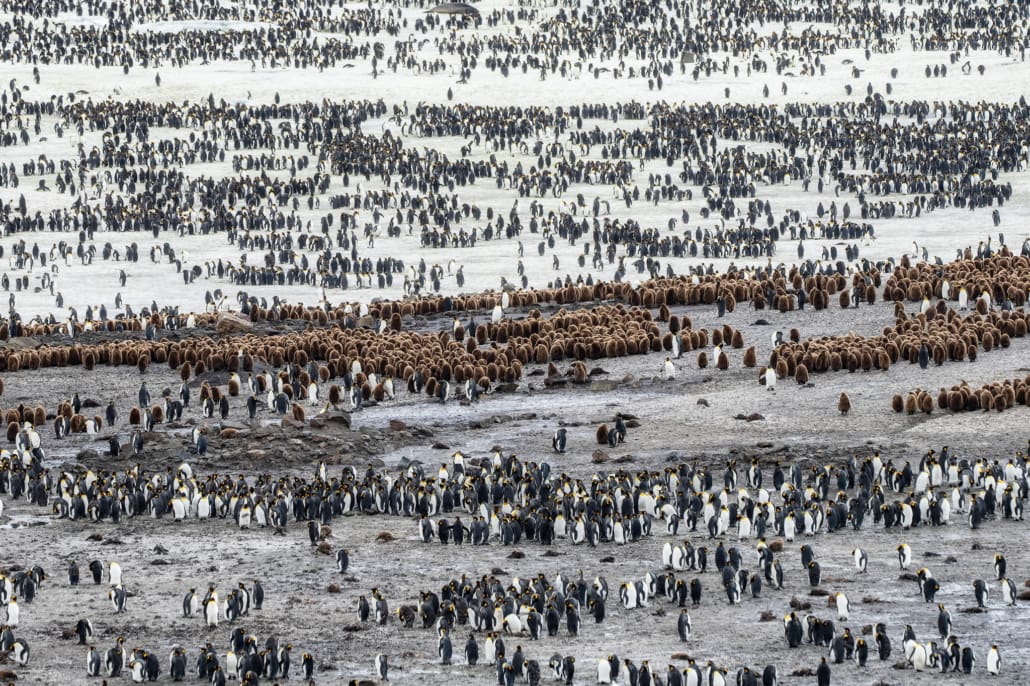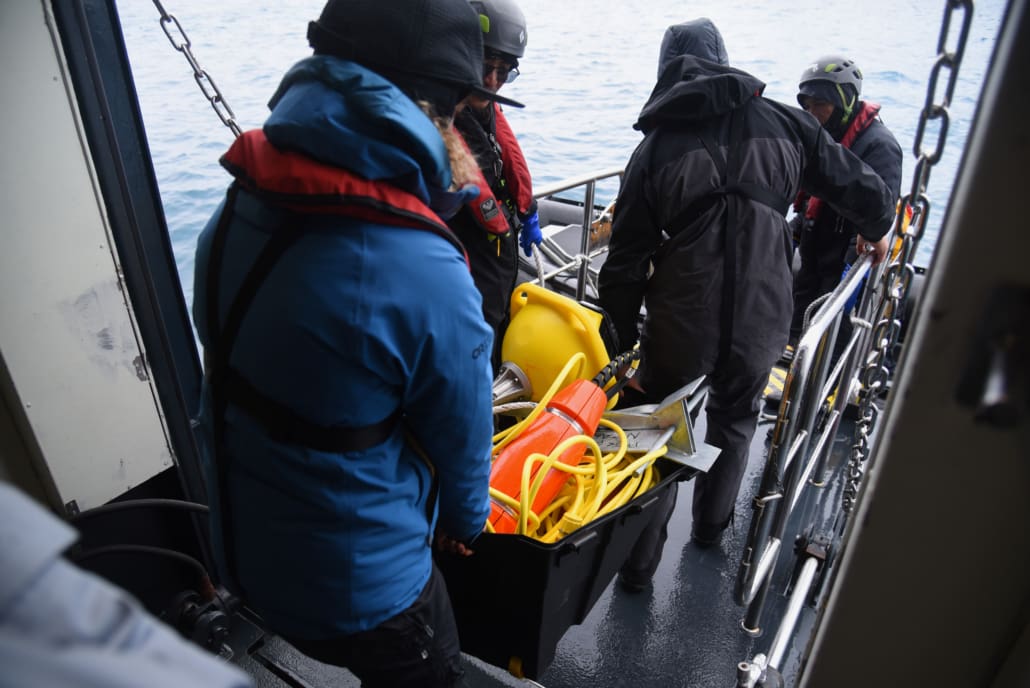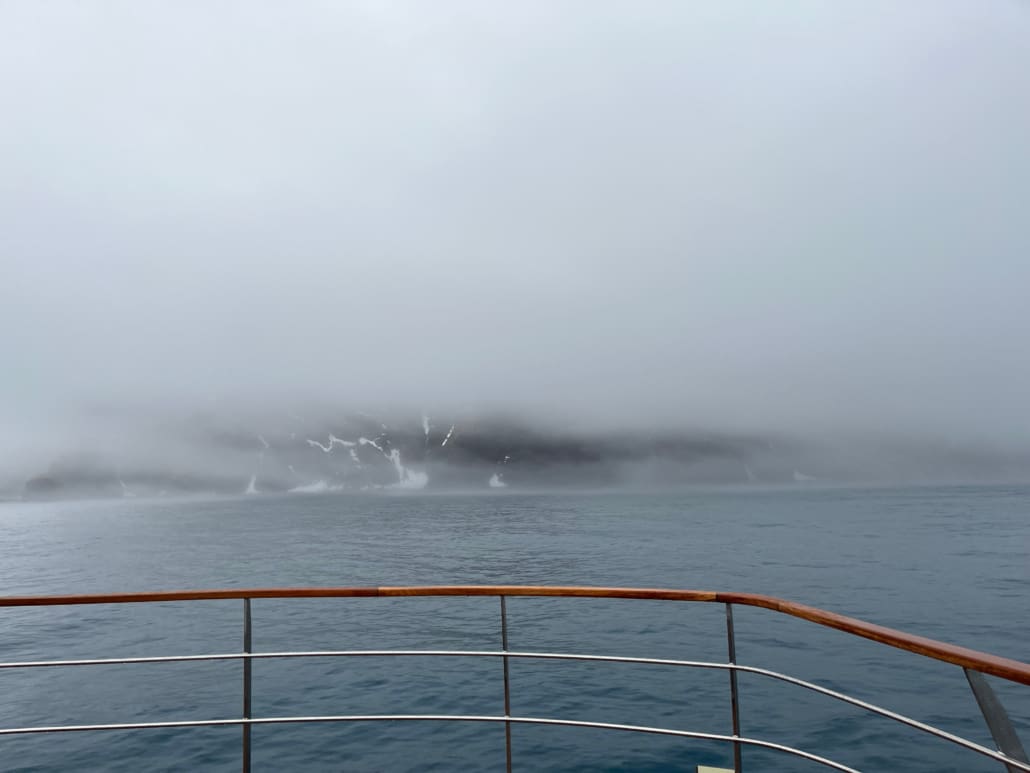Expedition Blog – Kelly Davenport, South Georgia 2023
Kelly Davenport was one of 22 young New Zealanders who travelled with the Trust to South Georgia in October 2023 for our ninth Inspiring Explorers Expedition™ to honour the centenary year of Sir Ernest Shackleton’s final expedition, the ‘Quest’.
The amazing weather of South Georgia Island
When people ask me what my experience in South Georgia was like, the word that comes to mind is overwhelming. Images of the enormous icebergs towering over the ship, insane numbers of penguins and wildlife, and mixed emotions from witnessing such a fragile and beautiful environment.
The main theme of the trip for me was weather. Maybe that’s because I’m a meteorologist – but it was hard not to witness the journey through the eyes of a weather observer and forecaster. Every memorable experience of the trip for me involved an element of the weather, which is to be expected as the climate of this area has such an impact on shaping the island and its biodiversity.
The insane number of penguins at St Andrew’s Bay. © Antarctica21/Rodrigo Moraga
The wind that delayed us – Sunday 1 October 2023
The journey began with an overnight flight from Auckland to Santiago. We then flew across the Andes on a stunning flight over impressive glaciers, active volcanoes, and steep forested fjords to Punta Arenas – one of the gateway cities to Antarctica.
Then, our travel got delayed. We couldn’t fly to the Falkland Islands (Las Malvinas) where we were due to depart by ship, as landing at the airport was deemed unsafe. The extremely strong northerly winds that were blowing across the hills north of the airport resulted in dangerous mountain waves and rotors which cause severe turbulence that would make the airport too dangerous to land at.
The weather played its hand, and we hadn’t even reached South Georgia yet.
Crossing the Antarctic Convergence – Wednesday 4 October 2023
As we sailed towards South Georgia across a vast blue ocean that stretched in all directions, the wind was relatively light and small fluffy clouds were scattered throughout the sky.
As we crossed the Antarctic Convergence, we experienced a huge shift in the weather. The clouds lowered and shrouded us, and the birds stopped flying behind the ship. The Antarctic Convergence is a marine belt encircling Antarctica. Within this zone, the cold dense surface waters of the circumpolar ocean sink and flow northward beneath the warmer subantarctic waters. When you cross this zone, the sea temperatures drop dramatically.
As we moved across the Antarctic Convergence, sea fog formed. This happens when wind pushes warm moist air across the cooler sea surfaces south of the Antarctic Convergence causing the moisture to condense and sea fog to form.
South Georgia lies on the Antarctic side of the Antarctic Convergence, so you could say that biologically we reached Antarctica (I’ve been to Antarctica!).
The first sighting of South Georgia – Thursday 5 October 2023
The fog had been following us around like a bad smell and we didn’t see much for days. Until, suddenly like magic, the fog cleared and we were treated to glistening icebergs in the distance with the peaks of South Georgia in sight.
“Land ho!”
It was a little taste of what was to come on the trip as the fog descended as we sailed towards our first destination, Right Whale Bay.
The first sighting of South Georgia with sea fog shrouding the island. © MetService/Peter Fisher
The Science team’s outreach project was our priority, so we zipped out on the first Zodiac to be able to deploy the wave buoy, a high-tech weather station that records high quality wind and wave data. Our modern-day meteorological data was on its way!
Right Whale Bay is a sheltered cove on the northeast coast of South Georgia and was shrouded in fog. When we first landed on the island, the wind was light, and the waters were calm. After three days at sea, it was a welcome feeling to finally be on land with the absence of humming ship engines and wind battering the ship.
The peacefulness of the weather, combined with the contrast of the loud wildlife when we first landed on the island, created an eerie atmosphere. I was suddenly overcome with emotion, witnessing the squawking penguins and roaring elephant seals. The surrealness and beauty of it all brought on the bittersweet realisation that I was lucky to be experiencing this. However, these animals devastatingly may not be around forever.
Deploying the spotter wave buoy. ©MetService/Peter Fisher
A close encounter with mid latitude weather – Saturday 7 October 2023
We sluggishly awoke to a thick soup of cloud in Possession Bay. We could see small chunks of ice in the bay, and it was peaceful and quiet. As we steamed ahead to Fortuna Bay the cloud broke apart and we were treated to our first blue skies in days. The wind arose and cut the cloud away from the steep peaks of South Georgia. We could see!
Possession Bay, a thick soup of cloud. ©AHT/Jenny Sahng
What we experienced was a cold front, an air mass change. The wind howled behind it, and we were lucky to land in Fortuna Bay. As the day progressed, the wind slackened slightly, and we were treated to bright blue skies and beautiful views in Stromness. This was the site where Sir Ernest Shackleton climbed down the waterfall and first reached civilization after the Endurance expedition.
The blue skies of Stromness compared to the soupy fog of Possession Bay were indicative of a different air mass in the morning, indicating that we crossed an air mass boundary, or rather, the air mass boundary crossed us – a front. We retrieved some great weather observations on this day to be able to highlight this weather event.
Fortuna Bay, we experienced strong winds behind the front. © Antarctica21/Rodrigo Moraga
Stromness, what a contrast to the thick fog in the morning. We experienced a frontal/air mass change. ©AHT/Jenny Sahng
Drygalski Fjord – Monday 9 October 2023
One of the biggest highlights of the trip was cruising into Drygalski Fjord. Imagine, 2000m peaks rising straight out of the ocean with glaciers cascading into the deep blue sea. Huge spectacular icebergs dotted everywhere the eye could see. It was possibly the most stunning scene of my life.
At the head of the fjord, we used Mangōpare sensors to measure ocean temperature close to the massive Risting Glacier. To get these samples we were unable to be deployed on Zodiacs as a howling northwester was blowing down the fjord, not too dissimilar to the one we experience on the Canterbury Plains of Aotearoa New Zealand. So instead, we took the samples from the ship.
One of the many stunning glaciers in Drygalski Fjord. ©MetService/Peter Fisher
Using the Mangōpare sensor to take ocean temperatures from the ship in Drygalski Fjord. ©Antarctica21/Rodrigo Moraga
The ride home – Thursday 12 October 2023
The journey home posed its own challenges, with swells reaching a staggering 10m. I don’t think I’ll ever experience seas quite like that again in my lifetime. I’m very thankful to the crew for looking after us and keeping us safe on this journey home.
I’d like to thank MetService and Antarctic Heritage Trust for the transformative opportunity that connected us with one of the most remote corners of the Earth. And a special thanks to my colleague, Peter Fisher, whose expertise, enthusiasm, and photography enriched the entire experience.
Finally, I’d like to give a shout out to my teammates. You are all such incredible people, from your fun and silliness, to your determination and passion for the world around us, you all inspire me every day.











